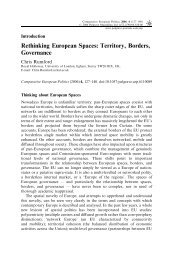Europeanisation, National Identities and Migration ... - europeanization
Europeanisation, National Identities and Migration ... - europeanization
Europeanisation, National Identities and Migration ... - europeanization
Create successful ePaper yourself
Turn your PDF publications into a flip-book with our unique Google optimized e-Paper software.
German–Polish relations 137<br />
society. On the basis of the increased Polish labour migration to Germany, in<br />
addition, these images are linked to renewed German stereotypes of the Poles as<br />
uncultured <strong>and</strong> cheap workers <strong>and</strong> sometimes even as criminals <strong>and</strong> thieves. 19 Due<br />
to the lack of an ethnic <strong>and</strong> nationalistic conflict as in the past, however, these<br />
revived images <strong>and</strong> stereotypes are less widespread, less powerful, more fluid <strong>and</strong><br />
also counteracted by more sympathetic <strong>and</strong> egalitarian images <strong>and</strong> views.<br />
On the Polish side, the successful role of the Solidarność movement, its sacrifice<br />
for the Polish nation <strong>and</strong> its contribution to the fall of communism in Pol<strong>and</strong> <strong>and</strong><br />
Eastern Europe was accompanied by a revival of Polish heroic-romantic nationalism<br />
<strong>and</strong> its core image of Pol<strong>and</strong>’s special mission for Europe. But this important current<br />
within Polish national identity was soon eroded along with the crisis-prone economic<br />
transformation process, the disintegration of Solidarność<strong>and</strong> the political come-back<br />
of the post-communists on the road to a consolidated democracy, the declining<br />
role of the intelligentsia <strong>and</strong> the rejection of the too powerful influence of the<br />
Catholic church. In addition, the imagined European mission soon conflicted<br />
with the requirement to adopt the acquis communautaire of the European Union.<br />
Moreover, the highly emotional public debate on Jedwabne destroyed the self-image<br />
of a solely benign <strong>and</strong> victimised Polish nation. With all this, the heroic-romantic<br />
character traits of Polish identity with its imagined cultural superiority of the<br />
Polish nation were substituted by more pragmatic orientations but also a renewed<br />
sense of cultural inferiority. This swing of the social psychological pendulum also<br />
affected the changing attitudes towards Germany. 20 On the one h<strong>and</strong>, Germany<br />
was accepted <strong>and</strong> also to a certain extent appreciated as the gateway to Europe <strong>and</strong><br />
also seen as the model of an economically <strong>and</strong> politically modern Europe. On<br />
the other h<strong>and</strong>, this also mobilised traditional stereotypes of the conquering <strong>and</strong><br />
dominating Germans aiming to return to their former l<strong>and</strong>s, sell out Polish farmers,<br />
invade Pol<strong>and</strong> by their economic power <strong>and</strong> use Brussels for these purposes<br />
(see Lang 2000). The revival of these traditional stereotypes were in addition<br />
supported by the rise of German neo-nationalist xenophobia <strong>and</strong> the frequent<br />
experiences of discrimination of Polish migrant workers in Germany. Still, taking<br />
together these positive <strong>and</strong> negative attitudes, the Polish levels of sympathy for the<br />
Germans have risen from marked antipathy in the early 1990s to medium sympathy<br />
at the end of the decade (CBOS 2000).<br />
In summarising this complex relational matrix between German <strong>and</strong> Polish<br />
society, it can generally be stated that the historical, structural <strong>and</strong> cultural<br />
asymmetries between the two societies have reappeared to a certain extent, but<br />
at the same time they have been crystallising in considerably changed forms. First,<br />
the economic core–periphery relation has been revived, but the <strong>Europeanisation</strong><br />
of the German economy <strong>and</strong> the exp<strong>and</strong>ing dynamics of the Polish economy have<br />
changed <strong>and</strong> diminished the traditional socio-economic inequalities <strong>and</strong> dependencies.<br />
Second, the political power hierarchy has been reconstituted, but the ethnic<br />
demographic separation of the two societies, the mutual acknowledgment <strong>and</strong> again<br />
the European mediation of German political hegemony have considerably eroded<br />
the former hierarchical nationalistic oppositions. And third, cultural asymmetries<br />
have reappeared, but the former religious Protestant–Catholic dualism interwoven



